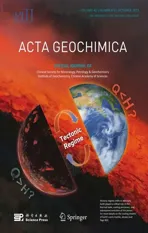Geochronology and geological significance of the strata of the Neoproterozoic Nanhua System,SW North China Craton
2023-10-13GuanxuChenLuoJinhaiSunGennianMengZhanChangYingleiChenZhuo
Guanxu Chen • Luo Jinhai • Sun Gennian • Meng Zhan • Chang Yinglei •Chen Zhuo
Abstract A set of low-grade clastic metamorphic and carbonate rocks,and greenschists outcropping in the southwestern (SW) margin of the North China Craton(NCC),was originally classified as the Paleoproterozoic Xiong’er Group according to stratigraphic correlation.To verify the age,this paper carried out detrital zircon U–Pb LA-ICP-MS dating of low-grade clastic metamorphic rocks exposed in the Changqing area at the SW margin of the Ordos Block in the SW part of the NCC.Results from detrital zircon dating indicate that the metamorphic and carbonate rocks can be classified into the Neoproterozoic Nanhua System,which is the only Nanhua System stratum in this block so far,and it probably could provide new clues to Rodinia break-up and Snowball Earth of the NCC.The nine peak ages of the low-grade clastic metamorphic rocks reflected its relatively complex provenance,and almost all major geological events experienced by the NCC basement since the Neoarchean,but some age peaks were difficult to correspond to that of the NCC,indicating that the southwestern part of the Ordos Block was also affected by the Qinling and Qiliang orogenic belts during Nanhua System of Neoproterozoic.Combined with provenance analysis,it was revealed that the current southwest boundary of the Ordos Block was the previous southwest boundary of the Ordos Block during the Qingbaikou-Nanhua Period of the Neoproterozoic.
Keywords The Ordos Block ∙Low-grade metamorphic rocks ∙Zircon U–Pb age ∙Paleoproterozoic ∙Neoproterozoic Nanhua System
1 Introduction
The original Paleoproterozoic Xiong’er Group (Fig.1) in Changqing town in the Southwestern(SW)Ordos Block of the SW North China Craton(NCC)is mainly composed of a set of greenschists(the Changqing greenschists)and lowgrade clastic metamorphic rocks and carbonate (the Changqing low-grade clastic metamorphic rocks and carbonate,Pt3C).The greenschists are in contact with the lowgrade clastic metamorphic rocks and carbonate by a normal fault and located on the hanging wall of the fault (Fig.2),and hence,these metamorphic rocks cannot form a uniform rock-stratigraphic unit.So far,accurate chronological data about these metamorphic rocks are absent,and their depositional environment and structural significance are not clear.According to zircon U–Pb dating results of the greenschists (Chen 2019) and the clastic interbedded rock in the greenschists(Chen et al.2019),the formation age of the greenschist protolith was restricted to Late Triassic-Early Jurassic.So,the greenschists should be disintegrated from the Xiong’er Group of Paleoproterozoic.In this case,whether the epiclastic metamorphic carbonate rocks still belong to the Xiong’er Group is worthy of further study.You(2016)provided207Pb/206Pb ages of 1091 ± 46 Ma–2854 ± 170 Ma using U–Pb LA-ICP-MS dating of detrital zircon on a low-grade metamorphic sandstone sample,indicating the deposition time of the metasandstone protolith should be later than 1091 Ma,and this time is markedly later than the formation time of the typical Xiong’er Group (1.80–1.75 Ga,Zhao 2004;1.80–1.78 Ga,Zhai et al.2014) outcropping in the southern part of the NCC.Thus,the preliminary determination is that the lowgrade metamorphic sandstone should not be classified as the Xiong’er Group.In this research,based on a detailed geological field survey in the Changqing area,detrital zircon U–Pb LA-ICP-MS dating analyses of multiple samples of low-grade clastic metamorphic rocks were performed to further constrain the formation time of this stratum.Further,we reveal the characteristics of the provenance area of the clastic rocks and discuss the regional structural characteristics of this set of low-grade clastic metamorphic rocks-carbonate when they were deposited.
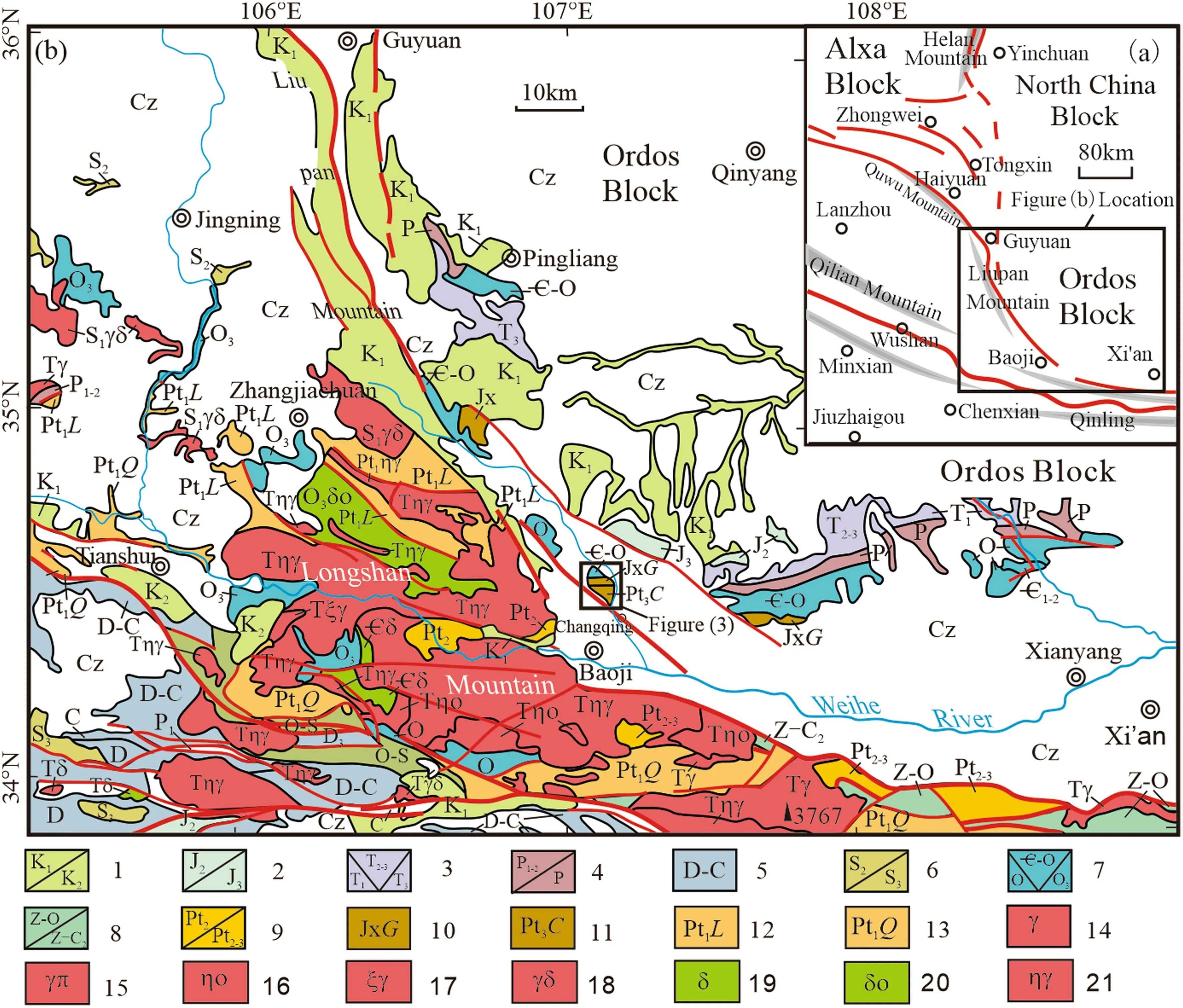
Fig.1 Simplified geological map of the southwestern margin of the Ordos Block,China and its adjacent area.1.Lower Cretaceous/Upper Cretaceous;2.Middle Jurassic/Upper Jurassic;3.Lower Triassic/Middle Triassic/Lower Triassic;4.Permian system/Lower Permian/Middle Permian;5.Devonian System-Carboniferous System;6.Middle Silurian/Upper Silurian;7.Ordovician System/Cambrian system-Ordovician System/Upper Ordovician;8.Sinian System-Ordovician System/Sinian System-Middle Cambrian.9.Mesoproterozoic/Mesoproterozoic-Upper Proterozoic;10.Guandaokou Group of Jixian System of Mesoproterozoic;11.Neoproterozoic Changqing low-graded metamorphic rocks in this paper;12.Palaeoproterozoic Longshan Group;13.Palaeoproterozoic Qinlong Group;14.Granite;15.Granite porphyry;16.Quartz monzonite;17.Syenogranite;18.Granodiorite;19.Diorite;20.Quartz diorite;21.Monzonitic granite

Fig.2 Representative field photos of the normal fault between the low-graded metamorphic clastic rock-carbonate and greenschist;A.Fault contact between the greenschist and calcareous slate;B.Prospect of the contact zone between the greenschist and calcareous slate;C.Partial enlarged photo of the fault cataclastic rock
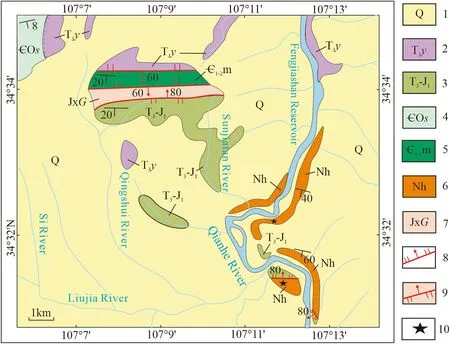
Fig.3 Geological map of the Changqing low-grade metamorphic clastic rock-carbonate outcrop area in the southern part of Fengjiashan Reservoir (modified after the 1:250,000 geological map of Baoji City,Shaanxi Provincial Geological Survey and Research Institute,2003.1:200,000 Baoji Geological Map.The 14th Unit of Qinling Regional Geological Survey Brigade,Shaanxi Provincial Geological Bureau,Ministry of Geology,1960,and the revision of the results are based on the authors’ investigation);1.Quaternary system;2.Upper Triassic Yanchang Formation;3.The Upper Triassic-Lower Jurassic greenschist disintegrated from the original Xiong’er Group;4.Cambrian-Ordovician Sanshanzi Formation;5.Lower-Middle Cambrian Mantou Formation;6.the low-graded metamorphic clastic rock-carbonate of Neoproterozoic Nanhua System disintegrated from the original Xiong’er Group;7.Guandaokou Group of the Jixian System of Neoproterozoic;8.normal fault;9.reverse fault;10.Sampling point
2 The geological background and petrological characteristics
The Changqing low-grade clastic metamorphic rock-carbonate is not widely exposed in the south of the Fengjiashan reservoir and is mainly exposed on both banks of the Qianhe River.The area around these rocks is mainly covered by the Quaternary system.At two outcrops on both sides of the riverbed,it can be seen that the rocks are in contact with the Upper Triassic-Lower Jurassic greenschists as a normal fault,where the schists are located in the hanging wall,and the metamorphic rock-carbonate in the footwall of the normal fault(Figs.2a,b,c and 3).Since the top and bottom interfaces of the low-grade clastic metamorphic rock-carbonate are not exposed,the thickness of this set of strata is unknown,and the exposed thickness is about 1000 m.
The low-grade clastic metamorphic rock-carbonate assemblage is mainly composed of limestone,marbled limestone,gray-black sericite slate,calcareous slate,and phyllite,intercalated with multiple layers of conglomerate and glutenite (Fig.4).The gray-white calcareous slate is about 10–15 cm thick,with plate structures,no recrystallized minerals visible to the naked eye,and very fine sericite locally.The variable residual bedding structure is retained in the rock,and the degree of metamorphism is relatively low.
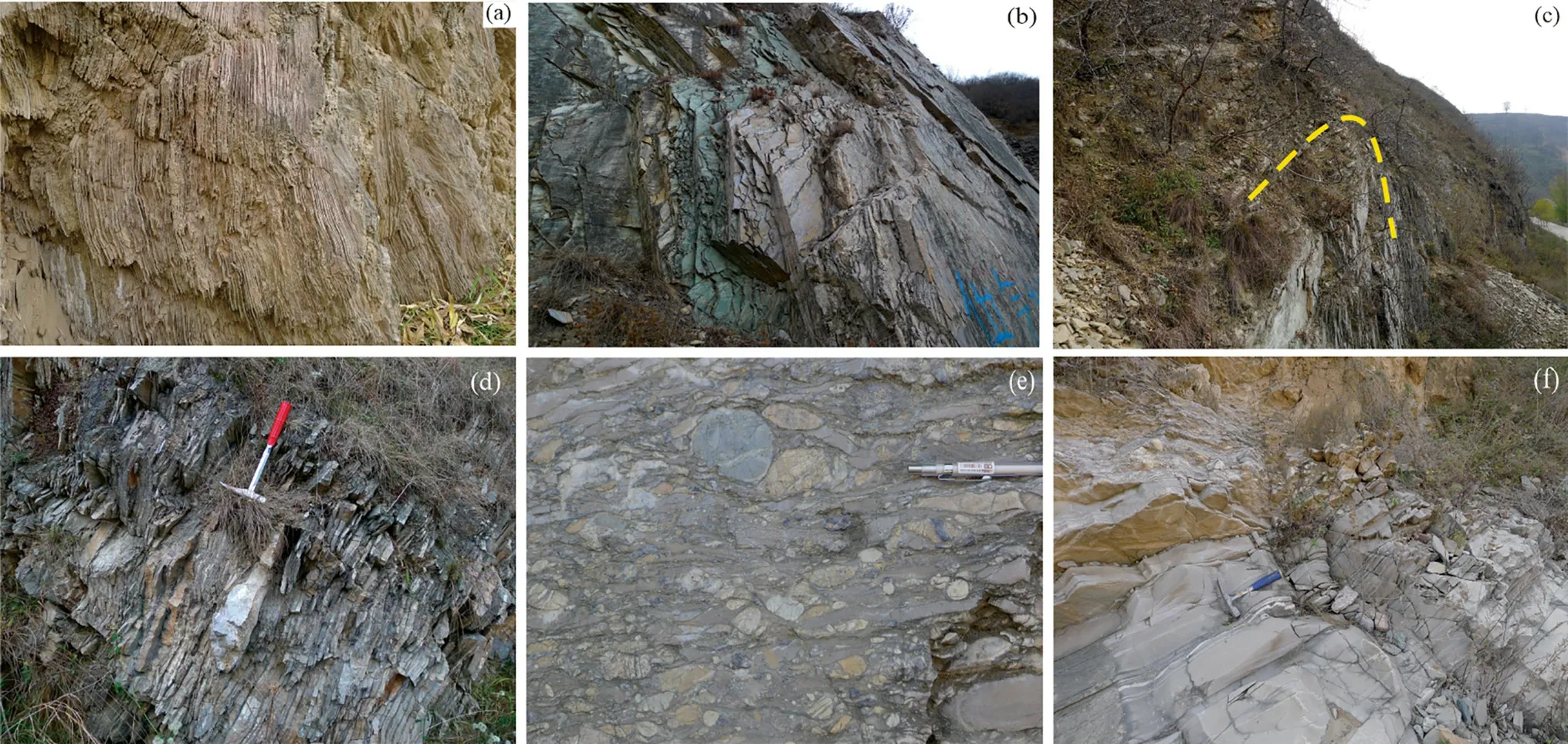
Fig.4 Photograph of the outcrop of the low-grade metamorphic clastic rock-carbonate in the southern part of Fengjiashan Reservoir a,b Calcareous slate on the east bank of the Qianhe River;c Anticline structure in the calcareous slate on the east bank of the Qianhe River;d Thin marbled limestone on the west bank of the Qianhe River;e Conglomerate interlayer on the west bank of the Qianhe River;f Sandstone interlayer on the west bank of the Qianhe River
Gray-black sericite slate and calcareous slate are mainly exposed on the eastern bank of the Qianhe River,occasionally intercalated with thin-layer quartzite,forming an anticline structure,with an anticline junction occurrence of 103°∠15° (Figs.4c and 5a).The western bank of the Qianhe River mainly exposes gray-black slate,middle-thin marble,and limestone,with multiple layers of gray-black,gray-white conglomerate,sandstone,and blastopsammite,forming a south-dipping monoclinic structure.The conglomerate has a complex gravel composition,mainly sandstone,limestone,metamorphic rock,etc.Gravels are sub-angular,poorly sorted,and the maximum diameter is about 5 cm (Fig.5b).

Fig.5 Geological section along the banks of the Qian River in the southern part of Fengjiashan Reservoir;1.conglomerate;2.glutenite;3.sandstone;4.limestone;5.marbled limestone;6.sericite,calcareous slate;7.Greenschist.The age sample 14LP01 in the picture is the Youjia(2016) dating sample
The blastopsammite is gray-white as a whole,with a medium-thick layered shape,and the original sedimentary bedding can be seen.The fresh side of the rock is pale gray.According to thin-section observation (Fig.6),the rock is supported by particles and has a variable sand-like structure with porous cementation.The content of debris is about 90%,sorting is relatively poor,and roundness is low(subangular).Mineral–mineral combinations are arranged in micro-directional arrangements,with the main components as quartz (~45%),rock fragments (~40%),a small fraction of mica,and other minerals (less than 5%).The rest are heterobase and cement (~10%).The composition of the rock fragments is relatively complex with mainly carbonate rock fragments,in addition to some sandstone and limestone detritus.The particle size of the detritus is not more than 3 mm,quartz presents a granular shape,where most of the particles have wavy extinction and the grains are small,with a particle size of 0.025–0.12 mm.Argillaceous and silicalite are the main interstitials with a small amount of iron oxide and calcium.It is named lithic quartz sandstone according to its mineral composition.

Fig.6 Photomicrograph of variable sandstone of the low-graded metamorphic clastic rock on the south side of Fengjiashan Reservoir.a,b and c are single polarized lights;Figures d,e,and f are orthogonally polarized lights corresponding to a,b,and c
From the thin-section study,it can be observed that the sorting and roundness of clastic particles are relatively poor,the content of detritus is very high,and the detritus is mainly carbonate.This reflects that the compositional maturity and structural maturity are relatively low,indicating that it is the product of near-source accumulation and that the provenance may be the coastal area adjacent to the active structural zones.
3 Analysis methods
Two samples of variable residual sandstone and one sample of quartzite (Fig.5a b for sampling locations) were selected at the Regional Geological Survey Institute of Langfang City,Hebei Province.For the sorted zircon,noncracked,colorless,and transparent particles under binoculars were selected,then fixed with epoxy resin,and polished until half of the zircon particles were exposed.Cathodoluminescence (CL) photography was then performed to reflect the internal structure of zircon.LA-ICPMSin-situisotope and trace element analysis and testing were further carried out.Zircon U–Pb dating,CL photography,and trace element analyses were completed in the State Key Laboratory of Continental Dynamics,Northwestern University,Xi’an.
For the zircon CL image,the CL luminometer used a CL probe loaded on a scanning electron microscope,Mono CL3+from Gatan,UK.U–Pb isotopic composition of zircon was tested using quadrupole ICP-MS Elan6100DRC.The laser beam used in the analysis has a spot diameter of 30 μm,a laser pulse of 10 Hz,and an energy of 32–36 mJ.In the analysis of age data,if the measuring point is <1000 Ma,the206Pb/238U age value is used;if the measuring point is >1000 Ma,the207Pb/206Pb age value is used instead.The concordance of the data at each measurement point of detrital zircon was calculated in combination with206Pb/238U,and the measurement point data whose age deviation between206Pb/238U and207Pb/206Pb was greater than ± 10% were eliminated.
4 Analysis results
Two sandstone samples and one quartzite sample are used for detrital zircon U–Pb LA-ICP-MS dating.The dating analysis data are listed in Tables 1 and 2.For the ancient zircons with age >1000 Ma,most of them have a certain degree of Pb-loss.The initial conditions of206Pb and207Pb are the same and the later geological environment has characteristics of synchronous changes.The ratio and the age of207Pb/206Pb are relatively stable.Therefore,due to its credibility (Diwu et al.2010),the age results of207Pb/206Pb were used for this study.For the data of zircon aged <1000 Ma,due to the low content of radioactive Pb that can be used and the uncertainty in the correction of ordinary Pb,the more reliable surface age of206Pb/238U was selected.
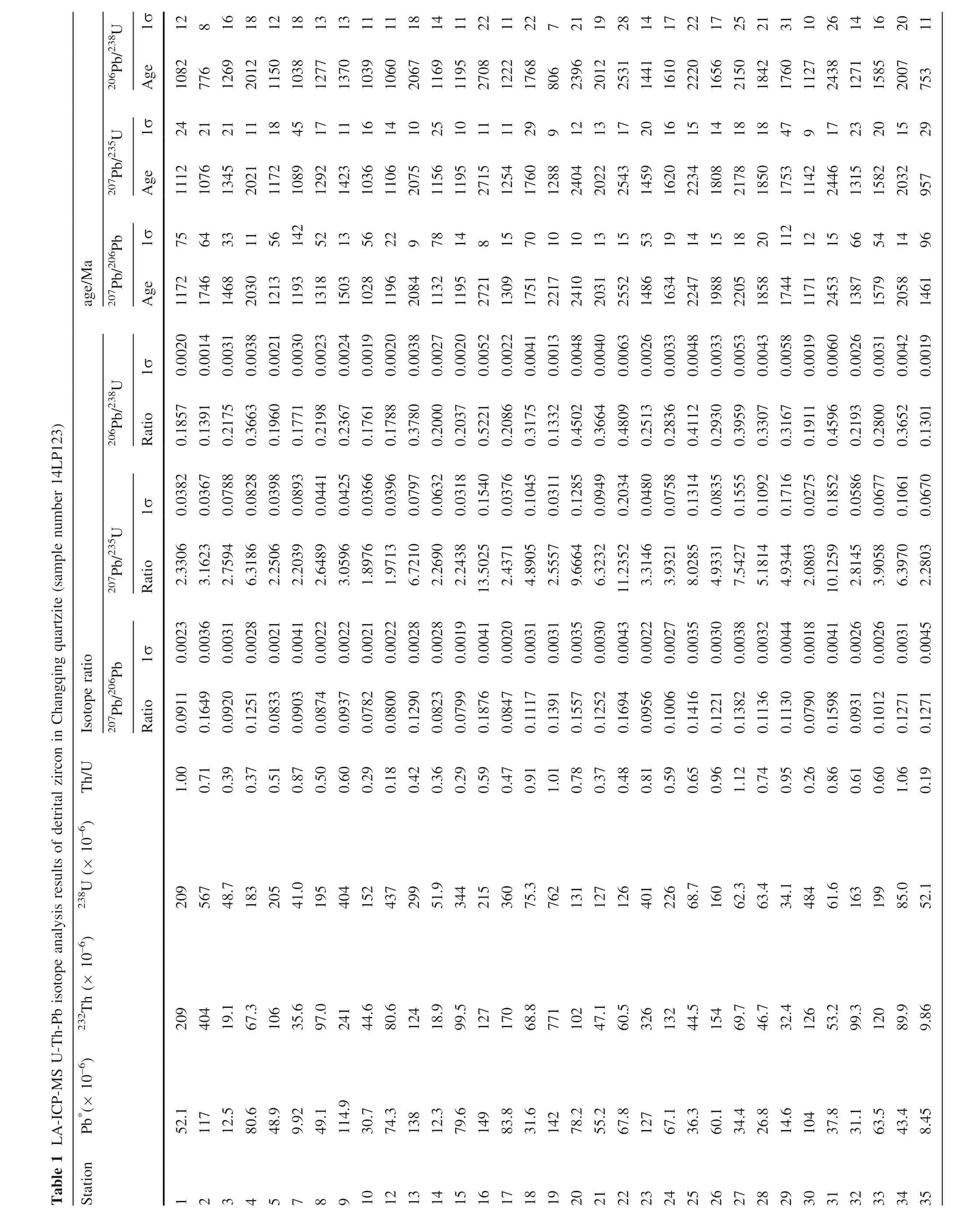
4.1 Detrital zircon U–Pb age of quartzite interlayer
In the sericite slate on the eastern bank of the Qianhe River,there are several layers of thin quartzite interlayers,each of which is about 2 to 3 cm thick,and locally formed into small clumps.The dating samples for this research were collected from small clumps of quartzite (Fig.5a),sampling point coordinates are 34°31′6.9′′N,107°12′9.2′′E,and the sample number is 14LP123.
The CL image of detrital zircon in quartzite is shown in Fig.7a.Zircon particles vary in size and mostly occur in the shape of long columns,containing a small amount of elliptical or round particles,with a particle size between 25 and 110 μm.A small number of particles have better selfshape and roundness,indicating that these zircons have undergone long-distance transportation and sorting,and are detrital in nature.A few particles in the sample developed oscillating belts,and the brightness of the zircons was uneven,where some were darker,which may be due to the higher content of Th and U.Th/U ratio of zircons was 0.18–1.78 (average 0.64),of which only four zircons had ratios less than 0.3.A higher Th/U ratio (>0.01) indicates most of the samples were of magmatic origin.Eighty zircons in the sample were analyzed,and the effective measuring points were 77 after calibration.These points were all located on the concordance line of the207Pb/235U—206Pb/238U concordant diagram,or distributed near it (Fig.8a),indicating that radiogenic Pb of zircon was not significantly lost,and the dating data is highly reliable.The age of206Pb/238U was between 753 ± 11 Ma and 2708 ± 22 Ma,while the age of207Pb/235U was between 907 ± 26 Ma and 2715 ± 22 Ma.A good concordance was observed in206Pb/238U and207Pb/235U(Table 1).The zircon age histogram (Fig.8b) shows five age peaks (755,1176,1500,1855–2030,and 2259–2418 Ma).
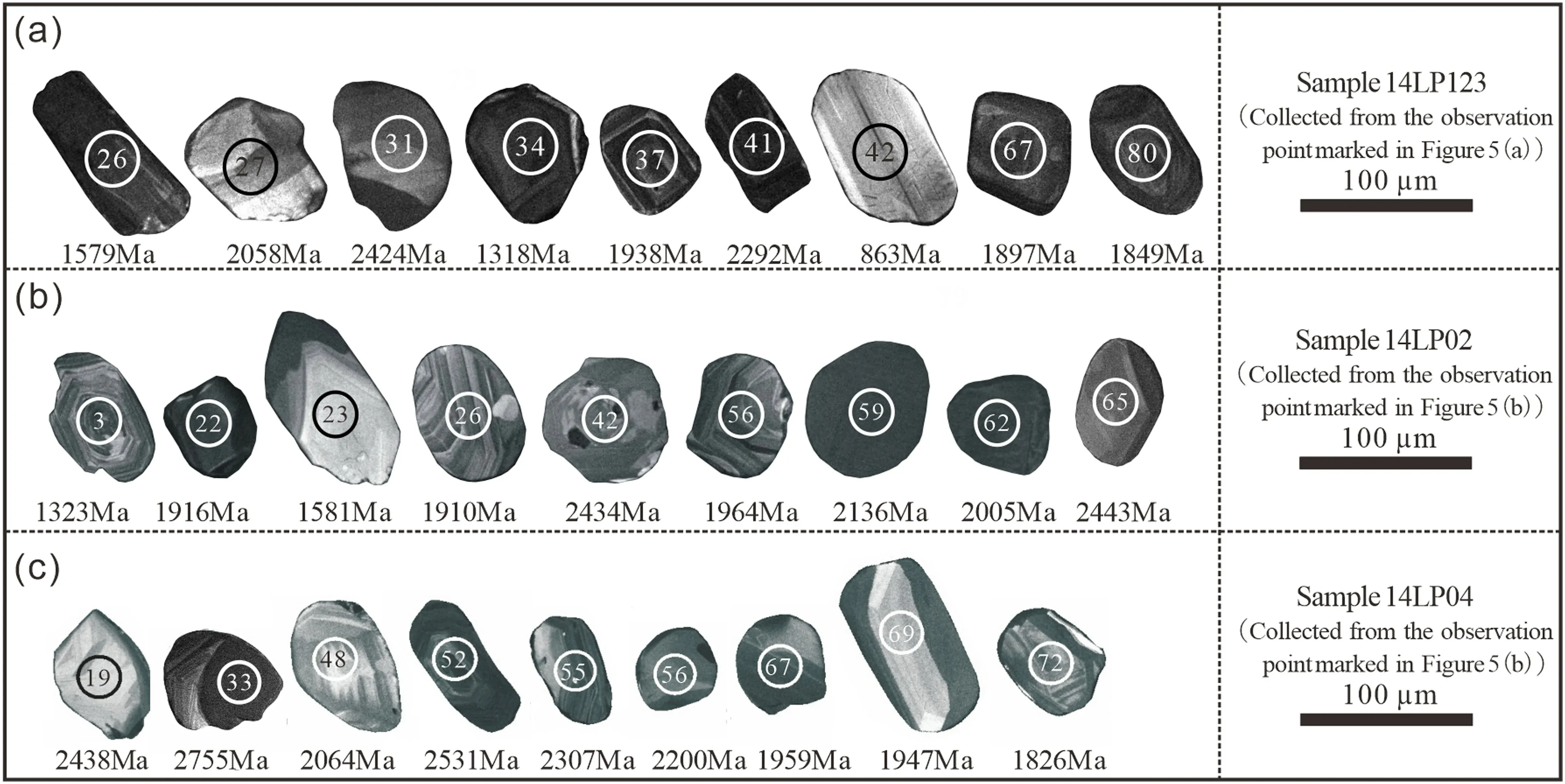
Fig.7 The cathodoluminescence (CL) image of detrital zircons from the samples 14LP123 a,16LP02 b,and 16LP04 c.The circle in the figure represents the location of the measuring point,the number in the circle represents the number of the measuring point,and the number around the zircon represents the age value of the corresponding measuring point (Ma)
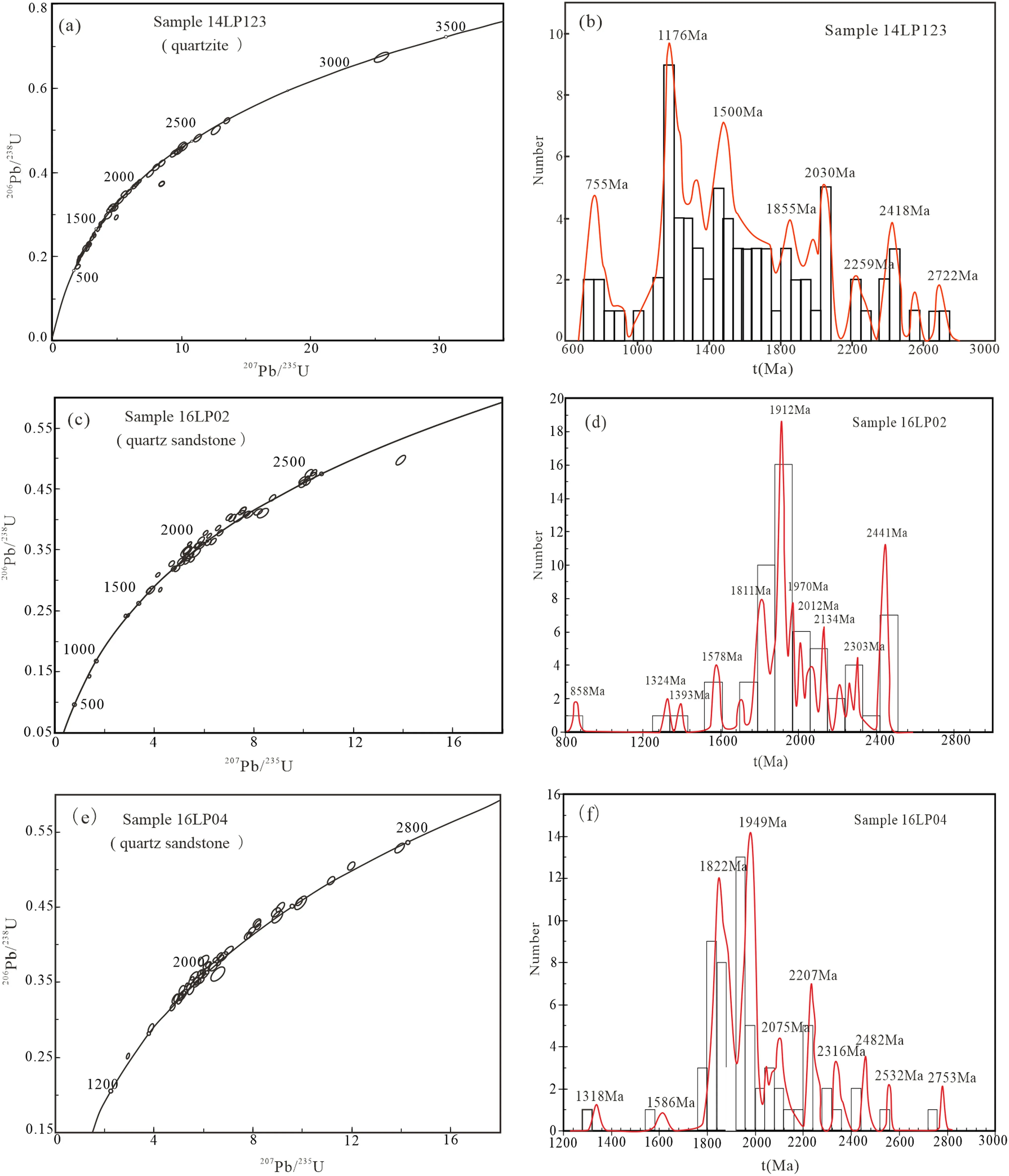
Fig.8 The Concordia diagrams and histograms of zircon U–Pb dating for samples 14LP123 a,b,16LP02 c,d,and 16LP04 e,f
4.2 The U–Pb age of the detrital zircon of sandstone
The sampling point of the low-grade metamorphic sandstone sample (16LP02) was 34°30′57.6′′N,107°12′4.0′′E,and the CL image of the detrital zircon in the sample is shown in Fig.7b.The particle size of zircon is between 40 and 120 μm,most of which are in short or long columns,oblong or round,and have good self-shape and roundness,indicating long-distance transportation and separation.Few zircons developed oscillating zoning,with a majority having no ring or fuzzy rings.Core mantle edge structure could be observed in some particles.Mostly,the brightness of zircon grains was uneven,while the darker ones could be due to the higher content of Th and U.The Th/U ratio of zircon was 0.22–2.32(average 0.73),which is greater than 0.1.A higher Th/U ratio (>0.01) indicated that the zircon is of magmatic origin.Out of the 71 zircons analyzed in the sample,the effective measuring points were 60 after calibration,located on or near the concordance line of207Pb/235U—206Pb/238U harmony diagram (Fig.8c),indicating that radiogenic Pb of zircon was not significantly lost,and the dating data is highly reliable.The age of206Pb/238U was between 854 ± 12 Ma and 2507 ± 19 Ma,and the age of207Pb/235U was between 883 ± 17 Ma and 2472 ± 10 Ma,indicating that206Pb/238U and207Pb/235U had a good degree of concordance (Table 2).The age histogram of zircon (Fig.8d) shows that the sample has five age peaks (858,1324–1393,1578,1912,and 2441 Ma).
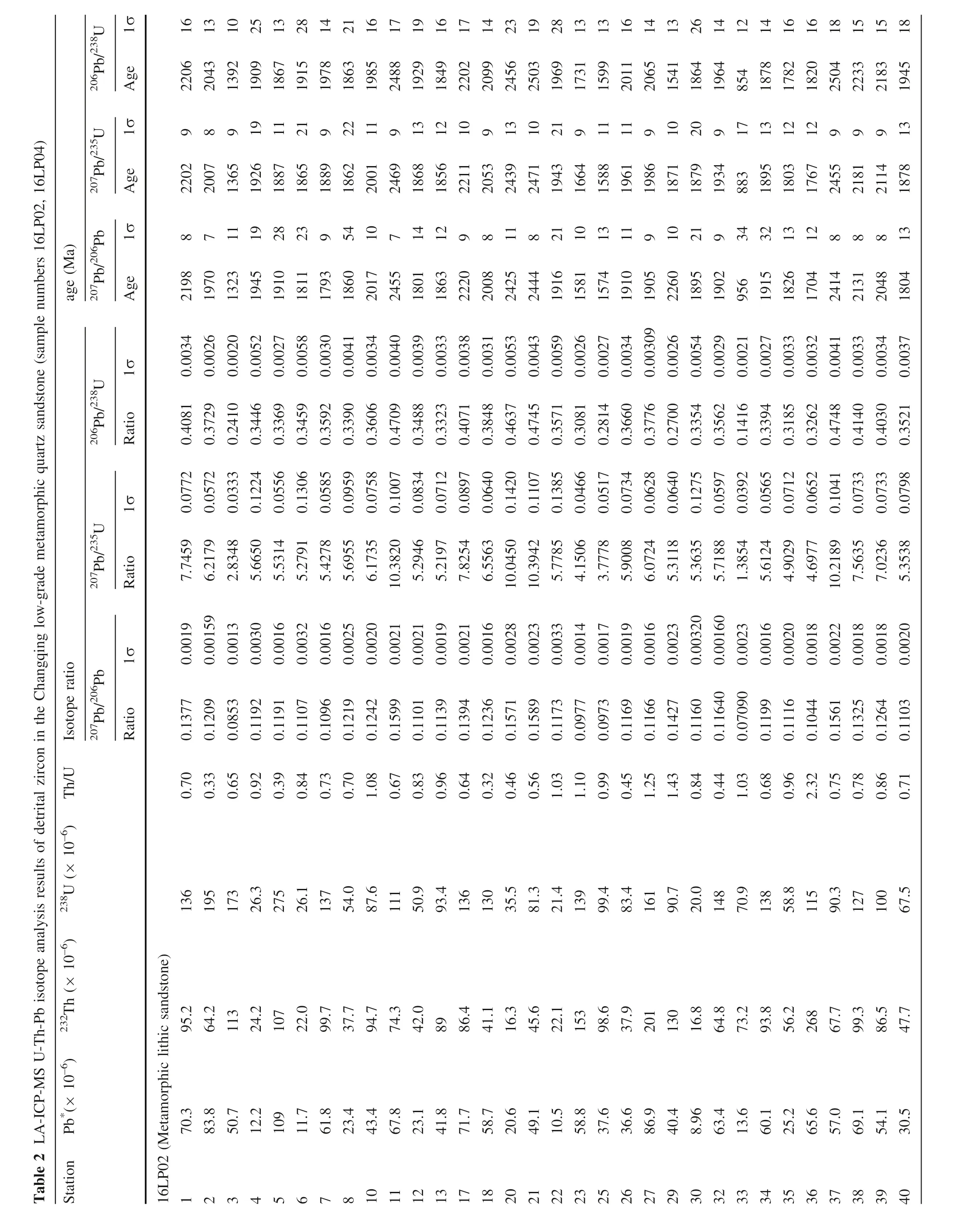
4.3 U–Pb ages of detrital zircons of sandstone 16LP04
Another low-grade metamorphic sandstone sample(16LP04) used in the detrital zircon U–Pb dating lay in coordinates 34°31′3.9′′N,107°12′7.6′′E (Fig.5b).The CL image of detrital zircon is shown in Fig.7c.The particle size of zircon was between 40 and 120 μm,the shape,structure,and brightness of the grains are similar to those observed in sample 16LP02.The Th/U ratio of zircon was 0.24–1.47 (average 0.74),which is greater than 0.1.A higher Th/U ratio (>0.01) indicates that the zircons in the sample are all magmatic.Out of the 72 particles analyzed,the effective measuring points were 64 after calibration,located on or near the harmony line of207Pb/235U—206Pb/238U harmony diagram (Fig.8e),indicating that the radiogenic Pb of zircon had no obvious loss,and the dating data is highly reliable.The age of206Pb/238U was between 1444 ± 11 and 2735 ± 18 Ma,and the age of207Pb/235U was between 883 ± 17 and 2472 ± 10 Ma,indicating that206Pb/238U and207Pb/235U had a good degree of concordance(Table 2).The zircon age histogram(Fig.8f) shows that the sample has five age peaks (1318,1586,1822–1949,2207–2316,and 2482–2532 Ma).
5 Discussion
Detrital zircon U–Pb dating results of the Changqing lowgrade clastic metamorphic rocks can indirectly limit the deposition time of this set of strata and provide new evidence for the stratum attribution.The detrital zircon age lineage of the rocks had good correspondence with the Neoarchean-Paleoproterozoic geological evolution of the NCC.The age spectrum was very similar to that of the Ordos basement before cratonization (~1.9–1.8 Ga) of the NCC,but great differences existed after cratonization.
5.1 Formation age and stratum attribution
The detrital zircon U–Pb dating results of the Changqing low-grade metamorphic sandstone and quartzite on the southern side of Fengjiashan Reservoir showed that the concordant age ranged from 753 to 2735 Ma.If the U–Pb system is not disturbed and the sample is not contaminated,the youngest age data obtained from the detrital zircon in the sedimentary rock sample would provide the maximum sedimentation age of the sediment (Nelson 2001).The minimum age was 753 Ma,with multiple measuring points near 753 Ma,indicating that it is not a coincidence,rather,the deposition age of low-grade metamorphic strata should be younger than 753 Ma.You (2016) analyzed the zircon U–Pb dating of the residual detrital sandstone to obtain an age of 1091 ± 46 to 2854 ± 170 Ma,indicating that the formation time of the low-grade clastic metamorphic rockcarbonate should not be earlier than 1091 Ma.
According to the stratigraphic contact relationship,the formation age of the Changqing low-grade clastic metamorphic rock-carbonate cannot be directly defined.Field observations showed that these rocks are in contact with the Changqing greenschist through normal faults,while the Guandaokou Group argillaceous limestone is overlaid on the greenschist in the southwestern part of Fengjiashan Reservoir.Considering that in the Miaopoli section of Qishan County,the Neoproterozoic Sinian Luoquan Formation is covered by parallel unconformities on the Guandaokou Group,and the Luoquan Formation is covered by platform facies Cambrian-Ordovician strata with parallel unconformities.Because the Fengjiashan Reservoir is not far from the Qishan Miaopoli section (about 41 km apart),it is inferred that the deposition time of the Low-grade clastic metamorphic rock-carbonate should be after 753 Ma and before Sinian.This period corresponds to the new Proterozoic Stretching Period or Nanhua Period.The period after 753 Ma and before Sinian corresponds to the Neoproterozoic Nanhua System (780–635 Ma) in the 2014 edition of ‘‘China Stratigraphic Table’’,and the Neoproterozoic extension in the 2018 edition of ‘‘International Chronological Table’’ Department (1000–720 Ma).Therefore,based on the U–Pb dating results of detrital zircon in the Changqing low-grade clastic metamorphic rocks,we classify the Changqing low-grade clastic metamorphic rock strata into the Neoproterozoic Nanhua System.Due to the integration and transition of the low-grade clastic metamorphic rock and the Changqing low-grade metamorphic carbonate rock,the entire Changqing lowgrade clastic metamorphic rock-carbonate rock can be classified as the Nanhua System.In other words,the lowgrade clastic metamorphic rock-carbonate rock of the original Xiong’er Group should be classified as the Nanhua System.The Nanhua System in China is mainly distributed in South China and the Tarim Basin(for example,Yin et al.2003;Feng et al.2004;Lu et al.2008;Gao et al.2013;Hu et al.2022;Gou et al.2022).In North China,only a few Nanhua systems are distributed in eastern Liaoning and eastern Shandong,such as the Qiaotou Formation,the Changlingzi Formation,the Yingchengzi Formation in eastern Liaoning,and Fuzikuang Formation in eastern Shandong,Mashan Formation,etc.(Gao and Chen 2003;Tang et al.2009).So far there has been no report about the Nanhua system on the southern margin of the NCC.Therefore,the Nanhua strata identified in this article in the southwest of the Ordos Block may be the first Nanhua strata exposed on the southern margin of the NCC.
Magmatism in rift environments and moraine rocks in cold climate environments are commonly developed in the Hanhua System in the Yangtze and Tarim blocks.Magmatism is the structural response to the breakup of the Rodina supercontinent,and moraine rocks are the sedimentary response to the ‘‘snowball Earth’’ (for example,Wang and Li 2003;Wu et al.2019).In this paper,we proposed the South China system shallow metamorphic clastic rock field determined in the southwest of Ordos block,indicating that although there are relatively few geological records preserved,there are the structural and sedimentary responses in the North China Craton to the breakup process of Rodina supercontinent and the‘‘snowball Earth’’.Our results provide new clues for this geological process.
5.2 Provenance characteristics of Changqing lowgrade clastic metamorphic rocks
Clastic zircons usually preserve the age records of rocks that once existed in the source area.They are one of the main ways to explore the formation and evolution of the NCC (Chen et al.2008;Li et al.2009;Hu et al.2009,2013;Wan et al.2010;Diwu et al.2011,2012,2013;Geng et al.2011;Hu et al.2012;Wang et al.2013;Ma et al.2016).By comparing the age spectrum characteristics of the detrital zircon with the age spectrum of geological events in the surrounding geological block,it is possible to reveal the characteristics of the provenance area.
The detrital zircon U–Pb dating analysis of three samples of low-grade clastic metamorphic rocks was combined and analyzed.The overall analysis reflected nine age peaks: 2755–2722,~2535,~2438,2302–2211,~2075,1952–1823,1584–1499,1318–1189,and 856–762,of which 1952–1823,~2438,~2075,and 2302–2211 Ma were several obvious age peaks (Fig.9).The ages at multiple peak periods reflect that the provenance of this set of low-grade clastic metamorphic rocks is relatively complex.
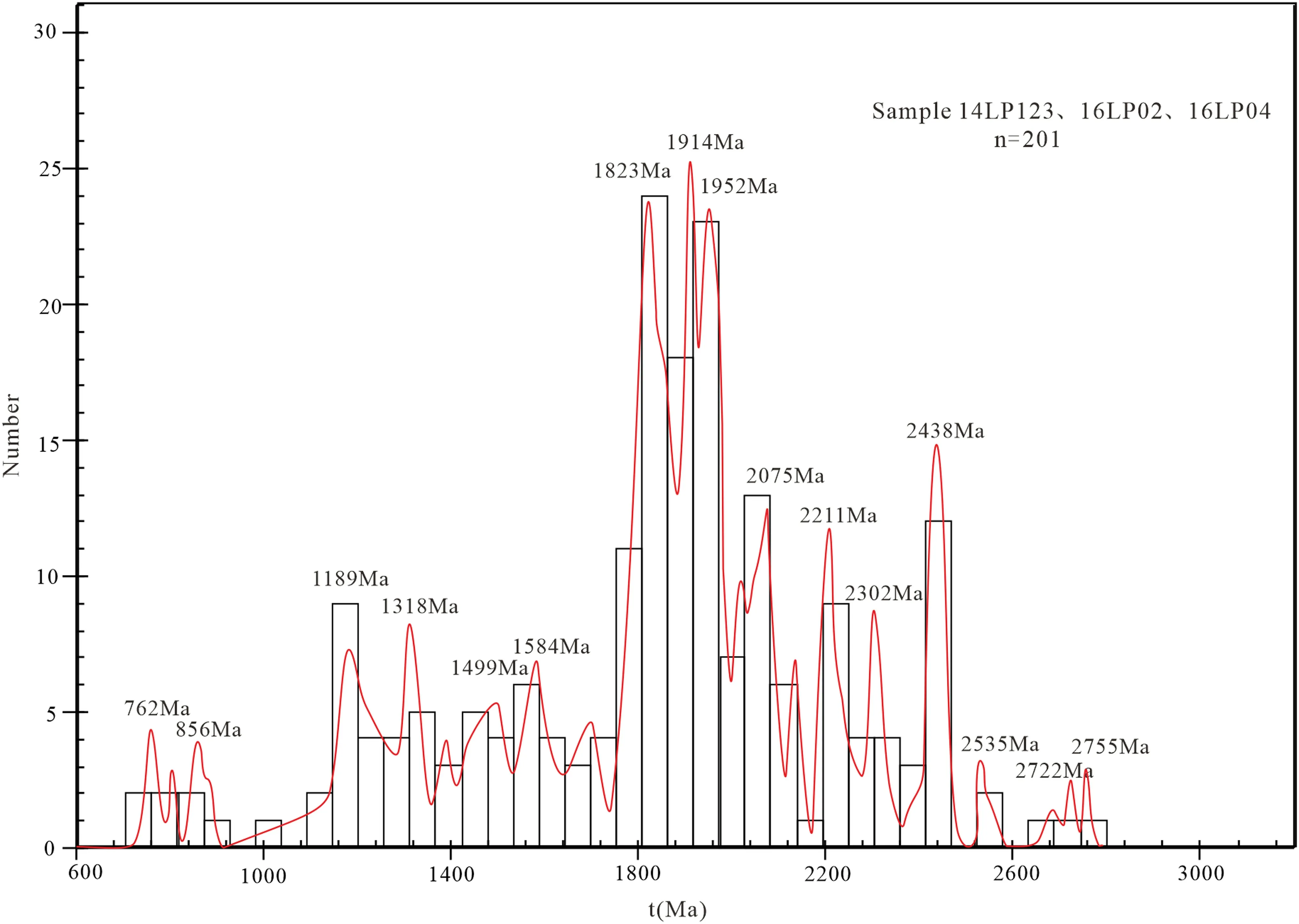
Fig.9 Histogram of U–Pb dating results of clastic zircons from Changqing low-grade metamorphic clastic rocks
The peak ages reflected almost all major geological events experienced by the NCC basement since the Neoarchean,including (1)~2.7 Ga large-scale continental crust growth;(2)~2.5 Ga Archaean micro-continental crust splicing welding,continental crust transformation and accretion (Diwu et al.2011;Zhai and Santosh 2011;Zhai 2011,2014;Zhang and Sun 2017).A large number of tonalite-trondhjemite-granodiorite rocks and crust-derived granites were formed (Shen et al.2005;Geng et al.2010);(3) 2.5–2.3 Ga Ordos Block ‘‘tectonic quiet period’’ (Zhong et al.2016);(4) 1.95–1.85 Ga Kongzi belt and the central orogenic belt were formed,and the basement of the NCC was cratonized (Zhao 2002,2009;Zhai and Peng 2007;Zhai 2011;Zhong et al.2016;Li et al.2016;Zhang et al.2018);(5)extension event corresponding to the Xiong’er Group from 1.80 to 1.75 Ga(Zhao 2004) and 1.80–1.78 Ga (Zhai et al.2014).The age peaks shown in Fig.9 correspond to the above-mentioned important geological events.However,some age peaks were difficult to correspond to.This indicates that the southwestern part of the Ordos Block was also affected by the tectonic structure of the neighboring areas when the clastic rocks of the Nanhua System of Neoproterozoic were deposited.The obvious influence is consistent with the state at the intersection of multiple tectonic units.
The peak age values of these nine periods had good correspondence with the Precambrian zircon age of the Ordos Block and surrounding West Qinling,Longshan,etc.,but mostly similar to the age spectrum of the Changcheng clastic rocks in the basement of the Ordos Block (Fig.10),it shows that the geological age corresponding to the Changcheng System is the late Paleoproterozoic (1800–1600 Ma),reflecting that the basement evolution of the study area and the Ordos Block has a certain degree of synchronization.Alternatively,the basement rocks of the Ordos Block and the Longshan Group may be the main source area of this set of lowgrade clastic metamorphic rocks,and the Qinling group and other groups may have provided some detritus material.

Fig.10 Zircon age histograms of the tectonic units around the study area.a,b Zircon age histograms of parametamorphic gneiss and clastic rocks of Great Wall System of Mesoproterozoic in the Ordos basement(according to Zhang et al.2018);c,d Zircon U–Pb age histograms of the Qinling rock group in the Qinling orogenic belt and the Kuanping rock group in the West Qinling(according to Gao et al.2015);e Zircon U–Pb age histogram of orthometamorphic rocks in the Longshan Group (according to Xu 2018);f U–Pb age histogram of detrital zircons from the Middle Devonian in the West Qinling (according to Chen et al.2008)
5.2.1 Late Neoarchean age group(2755–2722 Ma and~2535 Ma)
This peak age corresponded well to the zircon ages of the clastic rocks of the Changcheng System of Meso-Proterozoic in the base rocks of the Ordos Block (Fig.10b),reflecting that such rocks could be an important source area of these low-grade clastic metamorphic rocks.
The age peaks of 2755–2722 Ma were roughly equivalent to the age values of tonalite-trondhjemite-granodiorite rock (TTG) in the Lu mountain,Zhongtiao mountain,and Xiaoqinling areas in the southern NCC (Zhang and Sun 2017).The age peak of~2535 Ma was comparable to the widely developed magmatic metamorphic event of~2.5 Ga in the base of the North China Block (Zhang et al.2018),which is consistent with the tectonic evolution of the NCC in the Neoarchean.The NCC experienced a largescale continental crust growth in the middle of the Neoarchean (~2.7 Ga).At~2.5 Ga,the Archean microcontinents were spliced and welded,and the continental crust was strongly modified and underwent accretion(Diwu et al.2011;Zhai and Sanotosh,2011;Zhai 2011,2014;Wang and Zhang 2016),forming a large amount of TTG and crust-derived granite (Geng et al.2010),leading to the first cratonization process of the NCC(Zhai 2008,2011).
5.2.2 Early Paleoproterozoic age group(~2438 Ma,2302–2211 Ma)
This age group was relatively good with the zircon ages of the clastic rocks of the Changcheng System of Mesoproterozoic (Fig.10b),Qinling Group-Kuanping Group(Fig.10c,d),and Longshan Group(Fig.10e)at the base of the Ordos Block.Indicates that the Ordos Block,the North Qinling,and the Longshan tectonic belt may all be source areas of the low-grade clastic metamorphic rocks.This also means that the North Qinling and Longshan structures may be certain sediment transport channels between the belt and the study area.The strata between 2.47 and 2.35 Ga at the bottom of the Paleoproterozoic NCC were generally missing,reflecting a quiet period in the evolution history of the NCC (Zhong et al.2016;Yang et al.2018),and tectonic activities within the NCC may be mainly confined to the edge of the plot.On the northern and eastern margins of the Ordos Block,continental margin arc granites related to the subduction of the Paleoproterozoic (2.2–2.0 Ga) oceanic subduction that was developed(Zhang et al.2018).The 2.2–1.9 Ga volcanic rocks of the NCC have double peaks.The characteristics of volcanic rocks indicated that the Craton might have experienced strong extensional activities starting from 2.2 Ga (Yang et al.2018).The Yanliao rift trough and Xiong’er rift trough began to develop in the northern and southern margins of the NCC (Zhai et al.2014).
5.2.3 Paleoproterozoic age group(~2075 Ma and 1952–1823 Ma)
This age group was in the zircon ages of the parametamorphic rocks of the Ordos basement and the Changcheng system clastic rocks (Fig.10a,b),the Qinling,Kuanping(Fig.10c,d),and the Longshan rock groups(Fig.10e).All had corresponding reflections,suggesting that they may have a common source area.
During this period,strong tectonic events occurred within the NCC,which resulted in the cratonization of the basement of the NCC.The Yinshan Block and the Ordos Block merged to form the western land block at~1.9 Ga,and the western land block and the eastern land block merged at~1.85 Ga to form the unified basement of the NCC and finally completed the cratonization process of the basement of the NCC (Zhao and Sun 2002;Zhao 2009;Zhai 2011;Li et al.2016;Zhong et al.2016;Wang and Zhang 2016;Zhang et al.2018).
5.2.4 Middle-Neoproterozoic age group(1584–1499 Ma,1318–1189 Ma,and 856–762 Ma)
The age at this period was quite different from the age spectrum characteristics of the basement metamorphic rocks and Longshan rock group in the Ordos Block shown in Fig.10,but it was similar to the age spectrum characteristics of the Qinling and the Kuanping rock groups.It reflects that the source rock of the low-grade metamorphic rock may have been the source area of this period similar to the Qinling rock group and the Kuanping rock group,or the Qinling rock group and the Kuanping rock group,directly providing the sedimentary source for the study area.The age spectrum of this period was inconsistent with the age spectrum of the Ordos basement rock,implying that the basement of the Ordos Block may no longer have regional provenance characteristics at this time.There were no longer any magmatic events or metamorphic events with regional characteristics.In fact,the NCC including the Ordos Block was basically in a stable state after the late Paleoproterozoic(1.9–1.8 Ga)cratonization(Zhao and Sun 2002;Zhai 2008;Zhao 2009;Li et al.2016;Wang and Zhang 2016;Zhang et al.2018).Yanliao rift trough and Xiong’er rift trough of 1700–820 Ma developed only in the north and south margins (Zhai et al.2014),with the study area located outside the rift trough of the Xiong’er Group in the southern margin and less affected.
5.3 Sedimentary environment characteristics of Changqing low-grade clastic metamorphic rock-carbonate rock
Changqing low-grade clastic metamorphic rock-carbonate rocks were mainly gray-black sericite slate and calcareous slate.A small amount of slate was gray-green,and minor thin gray-black and gray-white layers of gray were exposed in the lower layer of the outcrop and marbled limestone.Gray-black mixed sandstone and complex conglomerate with a thickness of about 30 m were exposed as well.No sedimentary structures such as wave marks and oblique bedding were observed in the rocks.It is speculated that the sedimentary facies markers have been modified during the process of metamorphism.The sedimentary environment of the rocks was inferred based on the original rock,and the overall reaction was a sedimentary sequence from bottom to top and seawater from deep to shallow(Fig.11).The gray-black and gray-white thin limestone at the bottom should be formed in a Low-grade clastic-sea environment.The original sericite,calcareous slate,and thin sandstone and quartzite strata should be thin mudstone and carbonate evaporite.The sedimentary environment of this kind of rock is inferred to be the coastal tidal flat sedimentary environment.The sedimentary environment of 30 m thick sandstone and conglomerate intercalation was unique.The gravel composition of the conglomerate was complex,with certain rounding and no sorting,showing the characteristics of river sedimentation,and indicating that the sea level in the area had dropped significantly at that time.Consequently,the original coastal tidal flat environment became a river environment.Moraine rocks generally developed in the Nanhua System in southern China.Perhaps the fluvial conglomerates in the Changqing Nanhua System developed at the same time when the Nanhua Moraine rocks in southern China developed (for example,Yin et al.2003;Feng et al.2004;Hu et al.2022;Gou et al.2022).Largescale glacial action had led to a drop in sea level,which led to changes in the sedimentary environment of the Changqing Nanhua System.This issue needs to be further studied in the future.

Fig.11 Stratigraphic histogram of Changqing Nanhua system.The formation thickness in this figure is estimated
During the Nanhua Period,the plate subduction of the Qinling area mainly occurred in the South Qinling,which had no obvious influence on the study area.From 760 to 680 Ma,the southern Qinling underwent plate subduction in two places at the same time.The Shangdan Ocean Basin slowly subducted southward along the northern part of the Douling Block,and in the southern part of the Xiaomoling Block,an oceanic plate subducted northward along the Fenghuangshan suture zone.These two plate subductions led to the widespread development of volcanic and sedimentary rocks in the Shangwudang Group and Yanlinggou Group (Dong et al.2016).
The Nanhua deposits in the study area were likely affected by the Neoproterozoic-Early Cambrian rifting in the North Qilian Ocean Basin to the west.During the Neoproterozoic-Early Paleozoic,the North Qilian Ocean,Saishiten-Xitieshan Ocean,and the East Kunlun Ocean began to crack,and the Nanhua-Sinian Baiyangdong Group was deposited on the Central Qilian Block.The Baiyangdong Group is mainly a set of intracontinental rifted basin deposits (Jiang et al.2014).
Based on the U–Pb dating results of the clastic zircons in the Changqing low-grade clastic metamorphic rocks,this work constrains the deposition time of this set of strata to the Neoproterozoic Nanhua Period.And not far from this set of low-grade clastic metamorphic rocks,the Qingbaikou Guandaokou Group was exposed in the southwest of Fengjiashan Reservoir and on the Miaopoli section of Qishan.The sedimentary environment was different,but it was similar to the sedimentary environment of argillaceous limestone of the Guandaokou Group in the southwest of Fengjiashan Reservoir.From the Guandaokou Group to the Nanhua System in the southwest of Fengjiashan Reservoir,the sedimentary environment had a certain continuity.
The Guandaokou Group in the southwest of Fengjiashan Reservoir was dominated by platform marginal facies argillaceous limestone,while the Guandaokou Group in the Miaopolli section was dominated by platform facies carbonate deposits.Thus,when the Guandaokou Group and this set of Nanhua System clastic metamorphic rock-carbonate rocks were deposited (Qingbaikou to Nanhua),the area was located at the southwestern edge of the Ordos Block.In other words,the southwest boundary of the current Ordos Block was the southwest boundary of the Ordos Block from the Qingbaikou Period to the Nanhua Period.
6 Conclusions
(1) Based on the U–Pb dating results of detrital zircons in the Changqing low-grade clastic metamorphic rocks,this study classified the Changqing low-grade clastic metamorphic rock strata into the Nanhua System.
(2) The basement rocks of the Ordos Block and the Longshan Group may be the main source area of this set of low-grade clastic metamorphic rocks,and the Qinling group and other groups may have provided some detritus material.
(3) The southwestern boundary of the current Ordos Block was the southwest boundary of the Ordos Block from the Qingbaikou Period to the Nanhua Period.
AcknowledgementsThis research was funded by National Natural Science Foundation of China (Grant No.42072231).The authors thank You Jia,Xu Huan and Li Yifei for the assistance during fieldwork.
Declarations
Conflict of interestThe authors declare that we have no conflict of interest.The authors declare that we have no known competing financial interests or personal relationships that could have appeared to influence the work reported in this paper.
杂志排行
Acta Geochimica的其它文章
- The cooling models of Earth’s early mantle
- Petrology of lherzolite xenoliths of Hosséré Sédé volcano(Adamawa plateau,Ngaoundéré area,Cameroon)
- Distribution,risk evaluation,and source analysis of the heavy metals in the sediment deposition of the lower Shichuanhe River,Shaanxi,China
- Decoding the nature of interaction between felsic clasts and mafic magma in a subvolcanic magma chamber from amphibole–titanite transformation and chemistry
- Isotopic analysis based on terahertz spectrum
- In situ infiltration-precipitation processes in some rock systems
